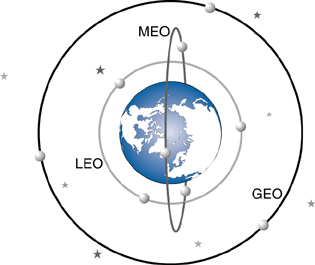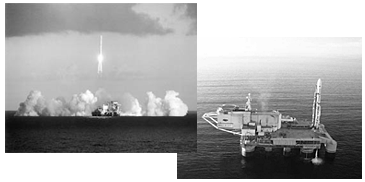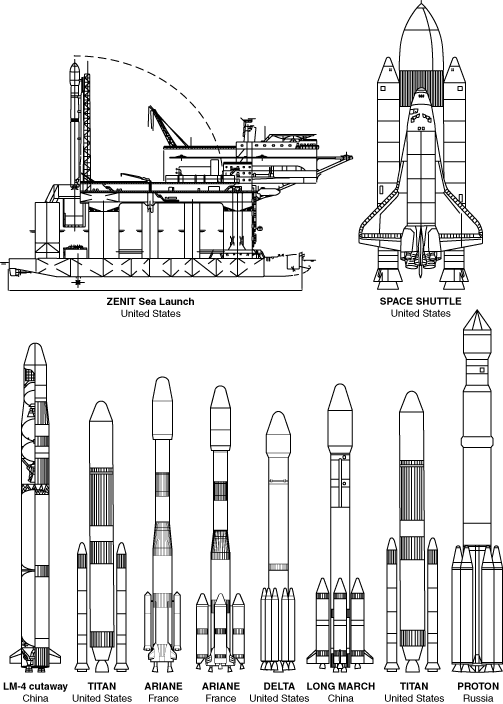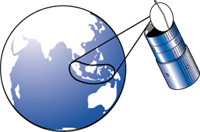A satellite is something that goes around and around a larger something, like the earth or another planet. Some satellites are natural, like the moon, which is a natural satellite of the earth. Other satellites are made by scientists and technologists to go around the earth and do certain jobs.Some satellites send and receive television signals. The signal is sent from a station on the earth’s surface. The satellite receives the signal and rebroadcasts it to other places on the earth. With the right number of satellites in space, one television program can be seen all over the world. Some satellites send and receive telephone, fax, and computer communications. Satellites make it possible to communicate by telephone, fax, Internet, or computer with anyone in the world.Other satellites observe the world’s weather, feeding weather information into giant computer programs that help scientists know what the weather will be. The weather reporters on your favorite TV news program get their information from those Still other satellites take very accurate pictures of the earth’s surface, sending back images that tell scientists about changes that are going on around the world and about crops, water, and other resources.
Some satellites send and receive telephone, fax, and computer communications. Satellites make it possible to communicate by telephone, fax, Internet, or computer with anyone in the world.Other satellites observe the world’s weather, feeding weather information into giant computer programs that help scientists know what the weather will be. The weather reporters on your favorite TV news program get their information from those Still other satellites take very accurate pictures of the earth’s surface, sending back images that tell scientists about changes that are going on around the world and about crops, water, and other resources. This is one kind of satellite—a Boeing 376, built by Boeing Satellite Systems. The Boeing 376 is used mostly for broadcast television and cable television.This is another, larger kind of satellite—the Boeing 601—which is also built by Boeing Satellite Systems. The Boeing 601 is used for many purposes, including direct broadcast TV, such as DIRECTV. Direct broadcast TV is a system for receiving television using a very small satellite dish. The television signal is relayed by a Boeing 601 satellite. The Boeing 601 also relays telephone, fax, and computer communications.The most powerful commercial satellite in the world is the Boeing 702. Designed and built by Boeing Satellite Systems, this giant has a wingspan of nearly 157 feet—more than a Boeing 757 jet plane.
This is one kind of satellite—a Boeing 376, built by Boeing Satellite Systems. The Boeing 376 is used mostly for broadcast television and cable television.This is another, larger kind of satellite—the Boeing 601—which is also built by Boeing Satellite Systems. The Boeing 601 is used for many purposes, including direct broadcast TV, such as DIRECTV. Direct broadcast TV is a system for receiving television using a very small satellite dish. The television signal is relayed by a Boeing 601 satellite. The Boeing 601 also relays telephone, fax, and computer communications.The most powerful commercial satellite in the world is the Boeing 702. Designed and built by Boeing Satellite Systems, this giant has a wingspan of nearly 157 feet—more than a Boeing 757 jet plane.
What is an orbit?
When a satellite is launched, it is placed in orbit around the earth. The earth’s gravity holds the satellite in a certain path as it goes around the earth, and that path is called an “orbit.” There are several kinds of orbits. Here are three of them.
LEO, or Low Earth Orbit
A satellite in low earth orbit circles the earth 100 to 300 miles above the earth’s surface. Because it is close to the earth, it must travel very fast to avoid being pulled out of orbit by gravity and crashing into the earth. Satellites in low earth orbit travel about 17,500 miles per hour. These satellites can circle the whole earth in about an hour and a half.
MEO, or Medium Earth Orbit
Communications satellites that cover the North Pole and the South Pole are placed in a medium altitude, oval orbit. Instead of making circles around the earth, these satellites make ovals. Receivers on the ground must track these satellites. Because their orbits are larger than LEOs, they stay in sight of the ground receiving stations for a longer time. They orbit 6,000 to 12,000 miles above the earth.
GEO, or Geostationary Earth Orbit
A satellite in geosynchronous orbit circles the earth in 24 hours—the same time it takes the earth to rotate one time. If these satellites are positioned over the equator and travel in the same direction as the earth rotates, they appear “fixed” with respect to a given spot on earth—that is, they hang like lanterns over the same spot on the earth all the time. Satellites in GEO orbit 22,282 miles above the earth. In this high orbit, GEO satellites are always able to “see” the receiving stations below, and their signals can cover a large part of the planet. Three GEO satellites can cover the globe, except for the parts at the North and South poles.
How Does a Satellite Get Into Space?
A satellite is launched on a launch vehicle, which is like a taxicab for satellites. The satellite is packed carefully into the vehicle and carried into space, powered by a rocket engine.Satellites are launched from only a few places in the world, primarily Cape Canaveral, Florida; Kourou, French Guiana; Xichang, China, and Baikonur, Kazakstan. The best places to launch satellites are near the ocean, so that when the launch vehicle falls away, it lands in the water and not on people.Another launch site actually travels to the perfect launch spot. The Sea Launch company rebuilt a big platform once used for oil drilling at sea. The platform carries satellites from Long Beach, California, to the equator, far out in the Pacific Ocean, where its rocket launches them.Putting everything together for a launch is very complicated. Many people in many companies and sometimes in many countries have to work together and coordinate their work so that everything will be ready for a launch. One of the ways things are coordinated is the countdown. In a countdown, we count down instead of up, because we are counting hours or minutes until liftoff—the moment when the rockets fire and the launch vehicle rises into the air. The last ten seconds of the countdown sound like this: 10, 9, 8, 7, 6, 5, 4, 3, 2, 1, liftoff! But the countdown starts long before the day of the launch. Everyone who participates in the launch has a schedule, and knows what he or she should be doing at 144 hours until liftoff, or 64 hours, or 7 hours, or 10 minutes. That’s how the launch planners make sure that everything will be ready at the right time.At launch, the launch vehicle’s rockets lift the satellite off the launch pad and carry it into space, where it circles the earth in a temporary orbit. Then the spent rockets and the launch vehicle drop away, and one or more motors attached to the satellite move it into its permanent geosynchronous orbit. A motor is started up for a certain amount of time, sometimes just one or two minutes, to push the satellite into place. When one of these motors is started, it’s called a “burn.” It may take many burns, over a period of several days, to move the satellite into its assigned orbital position.When the satellite reaches its orbit, a motor points it in the right direction and its antennas and solar panels deploy—that is, they unfold from their traveling position and spread out so the satellite can start sending and receiving signals.
satellites from Long Beach, California, to the equator, far out in the Pacific Ocean, where its rocket launches them.Putting everything together for a launch is very complicated. Many people in many companies and sometimes in many countries have to work together and coordinate their work so that everything will be ready for a launch. One of the ways things are coordinated is the countdown. In a countdown, we count down instead of up, because we are counting hours or minutes until liftoff—the moment when the rockets fire and the launch vehicle rises into the air. The last ten seconds of the countdown sound like this: 10, 9, 8, 7, 6, 5, 4, 3, 2, 1, liftoff! But the countdown starts long before the day of the launch. Everyone who participates in the launch has a schedule, and knows what he or she should be doing at 144 hours until liftoff, or 64 hours, or 7 hours, or 10 minutes. That’s how the launch planners make sure that everything will be ready at the right time.At launch, the launch vehicle’s rockets lift the satellite off the launch pad and carry it into space, where it circles the earth in a temporary orbit. Then the spent rockets and the launch vehicle drop away, and one or more motors attached to the satellite move it into its permanent geosynchronous orbit. A motor is started up for a certain amount of time, sometimes just one or two minutes, to push the satellite into place. When one of these motors is started, it’s called a “burn.” It may take many burns, over a period of several days, to move the satellite into its assigned orbital position.When the satellite reaches its orbit, a motor points it in the right direction and its antennas and solar panels deploy—that is, they unfold from their traveling position and spread out so the satellite can start sending and receiving signals.
These launch vehicles are used to send our satellites into space.
What Does a Satellite Do?
Satellites do many things for people. Their most important job is helping people communicate with other people, wherever they are in the world.
- A satellite can carry a camera as it travels in its orbit and take pictures of the whole earth. Mapmakers can use these pictures to make more accurate maps. Satellite pictures can also help experts predict the weather, because from the satellite, the camera can actually see the weather coming. When you watch the weather forecast on TV, you are seeing pictures of the earth taken by a camera riding on a satellite.
- Satellites in orbit can send messages to a special receiver carried by someone on a ship in the ocean or in a truck in the desert, telling that person exactly where he or she is.
- A satellite can relay your telephone call across the country or to the other side of the world. If you decide to telephone your friend in Mexico City, your call can be sent up in space to a satellite, then relayed to a ground station in Mexico and sent from there to your friend’s telephone.
- A satellite can relay your computer message, your fax message, or Internet data as well. With the help of satellites, we can fax, e-mail, or download information anyplace in the world. When the satellite sends a message from your computer or fax to another computer or fax, it’s called data transmission. The satellite is transmitting, or sending, information or data.
- A satellite can transmit your favorite TV program from the studio where it is made to your TV set—even if the studio is in Japan and your TV set is in Inglewood. From the studio where it is made, a TV program is broadcast to a satellite. This is called an uplink. Then it is rebroadcast from the satellite to another place on the earth. This is called a downlink. To link means to connect. So uplink is connecting upward to the satellite and downlink is connecting downward to earth.
When words or pictures or computer data are sent up to a satellite, they are first converted to an invisible stream of energy, called a signal. The signal travels up through space to the satellite and then travels down from the satellite to its destination, where it is converted back to a voice message, a picture, or data, so that the receiver can receive it.
Some satellites have a digital signal processor, which is like a very powerful computer. While they orbit, these satellites can change the kind of work they do and the places they send signals.
What’s Inside a Satellite?
Satellites have a great deal of equipment packed inside them. A satellite has seven subsystems, and each one has its own work to do.
1. The propulsion subsystem includes the electric or chemical motor that brings the spacecraft to its permanent position, as well as small thrusters (motors) that help keep the satellite in its assigned place in orbit. Satellites drift out of position because of solar wind or gravitational or magnetic forces. When that happens, the thrusters are fired to move the satellite back into the right position in its orbit.
2. The power subsystem generates electricity from the solar panels on the outside of the spacecraft. The solar panels also store electricity in storage batteries, which provide power when the sun isn’t shining on the panels. The power is used to operate the communications subsystem. A Boeing 702 generates enough power at the end of its service life to operate two hundred 75-watt light bulbs.
3. The communications subsystem handles all the transmit and receive functions. It receives signals from the earth, amplifies or strengthens them, and transmits (sends) them to another satellite or to a ground station.
4. The structures subsystem distributes the stresses of launch and acts as a strong, stable framework for attaching the other parts of the satellite.
5. The thermal control subsystem keeps the active parts of the satellite cool enough to work properly. It does this by directing the heat that is generated by satellite operations out into space, where it won’t interfere with the satellite.
6. The attitude control subsystem maintains the communications “footprint” in the correct location. Satellites can’t be allowed to jiggle or wander, because if a satellite is not exactly where it belongs, pointed at exactly the right place on the earth, the television program or the telephone call it transmits to you will be interrupted. When the satellite gets out of position, the attitude control system tells the propulsion system to fire a thruster that will move the satellite back where it belongs.
7. Operators at the ground station need to be able to transmit commands to the satellite and to monitor its health. The telemetry and command subsystem provides a way for people at the ground stations to communicate with the satellite.
Who Owns the Satellites?
Satellites are usually owned by companies or countries. The companies that own satellites usually want to make money by renting out part of the satellite to other companies. The countries or government agencies that own satellites want to make people’s lives better by improving the communication networks in their countries.
For example, Indonesia is a country made up of 13,677 islands whose people speak more than 250 languages. Imagine how much time and money it would take to connect them all with wires and telephone poles. Using satellites, Indonesia bridged all the islands at once and helped people learn the national language.
Being able to communicate better with people all over the world helps countries develop trading opportunities, increase business, and get information they need. Many countries—including Australia, Brazil, Canada, China, Japan, Luxembourg, Malaysia, Mexico, Norway, Sweden, Thailand, and the United States—are now increasing opportunities for their people by buying satellites.
Many large companies also own and operate satellites. They may rent space on the satellite to other companies and businesses. For example, a large communication company might buy a satellite and then rent space on the satellite to television companies, telephone companies, Internet service companies, and businesses that want to do business in other parts of the world 
A satellite operator can let its satellite “see” as much as one-third of our planet at a time, or it can shape the signal to reach a smaller area. For example, if you were the Indonesian telecommunications company, you might want your satellite signal to cover only Indonesia, and not spill over into other countries. The satellite signal can be shaped to cover the exact area that the operator wants to reach. Some satellites can divide their signal into many movable spot beams. Like a tight, bright flashlight beam, a spot beam can be aimed at an exact small area on earth, then moved elsewhere to reach new or different customers.
The area of the earth’s surface covered by a satellite’s signal is called the satellite’s footprint.



